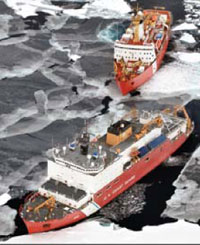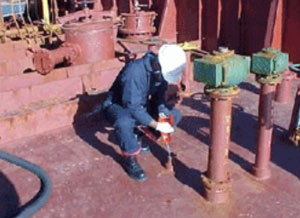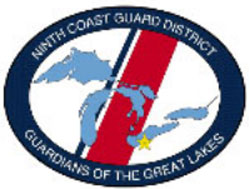SLD sat down in mid-March with Rear Admiral Peter Neffenger, District Commander for the Ninth Coast Guard District which has oversight of the Great Lakes. The Admiral discussed with us the role of the USCG in the Great Lakes region and the challenges to securing maritime commerce in the region.

SLD: How would you describe the Great Lakes region and the USCG role in that region?
Admiral Neffenger: Our role here is much the same as for the Coast Guard elsewhere with strong support for maritime safety, security and pollution prevention and response programs and operations. I’ll amplify these later and discuss some of our unique roles here such as significant ice breaking to keep the marine highways open and programs to guard against invasive species to protect our waters in close cooperation with our great partners in Canada.
What makes the Great Lakes interesting are a number of things. First of all, just to set the scene, you have internal domestic waters but they’re shared domestic waters of two sovereign nations; and that in and of itself is fascinating because international maritime law does not typically apply here.
Instead there are a number of bi-national maritime agreements that we use to help us govern maritime operations on the Great Lakes. These cover things like search and rescue, cross border law enforcement, aids to navigation, ice breaking, pollution prevention and clean up, and the like. The question is, how do we jointly manage these shared domestic waterways? Many vessels transiting the Great Lakes and St. Lawrence Seaway cross the border many times in the course of moving through the system so a joint approach with Canada is key.
By agreement, we incorporate international treaties for purposes of the Great Lakes but they don’t necessarily have to apply. So that makes it fascinating because it’s a region where you don’t have the weight of international agreement to drive you to action but you have the demands of commerce on both sides along with the day-to-day reality of operating on these waters that force the action.
The other thing that makes it interesting is that you have eight states and two Canadian provinces, each of which has jurisdiction out to their respective pieces of the international border. So unlike a coastal state which has jurisdiction that ends typically three miles out and then everything else from three to twelve is US federal jurisdiction and beyond that is the high seas and EEZ and so forth; well it’s not like that here.
So you have a domain in which there are many, many governmental actors present with quite a bit of interaction amongst all those actors. And just as an example, one case where that is posing some significant concerns and problems and issues for both sides is the management of ballast water. I don’t know how familiar you are with the ballast water issue but invasive species is a huge issue in the Great Lakes. In fact, it’s probably the number one issue here.
SLD: Ballast water is the water dumped from ships?
Admiral Neffenger: Exactly. Foreign, ocean-going vessels have been coming into the Great Lakes through the St. Lawrence Seaway since 1959. Many of them carry fresh water ballast from overseas, come over, then discharge their ballast in the lakes when they take on cargo and they leave. Well, some 70 or so invasive species out of 180 so far identified in the Great Lakes have been tied to past discharges of ballast water from foreign ships.
So for some time now we’ve been concerned; actually 1993 is when the Coast Guard first started looking at the management of ballast water — and by management we mean looking to see what’s being discharged into the lakes. Since 2008, we’ve actually done 100 percent examination jointly with Canada up in Montreal of all ballast tanks of every so-called saltie entering the Great Lakes system. (Saltie is what the Great Lakes maritime industry calls the vessels coming from overseas.) We check for evidence of open ocean exchange of that fresh ballast water with ocean salt water.
So we look for salinity in the ballast tanks. The idea being that if you do an open ocean exchange of ballast water, it should kill any fresh water organisms that might be there. Science says it removes about 95 to 98 percent of fresh water organisms. Long story short, what that means is that since 2008 there has been no unmanaged ballast water entering the Great Lakes system – that is, all ballast water brought into the Great Lakes has either been exchanged with open ocean salt water or is retained on board the ship. As I noted, there’s a great deal of concern about foreign species being put into the lakes.
SLD: So it’s from species from seagoing vessels.
Admiral Neffenger: Exactly, coming from seagoing vessels. There’s also some question about Interlake movement but the real issue is the potential for invasive species to come in from overseas. Some groups have even proposed extreme measures to include closing the seaway and the various connecting canals and locks to oceangoing vessels from overseas. I think that this is unrealistic and unnecessary, but it illustrates that this is a very, very big issue.
As an aside, it’s important to note that there are two approaches to ballast water management; one is salt water exchange as I just mentioned, the other is to treat the ballast water before or during discharge to remove any harmful organisms. Ballast water treatment is the approach taken recently by the International Maritime Organization (IMO). Treatment is also the approach the Coast Guard has taken in our proposed regulations for ballast water management which we published in late August 2009. This is a proposed rule, not yet in effect, that would require ships to treat ballast water under a two-phased approach. The first phase would require ships to meet the IMO concentration-based standard for treatment initially, then would require a much stricter concentration-based standard in phase two following a practicability review of the current state of technology.
Meanwhile, in the absence of new federal legislation and while awaiting implementation of the proposed Coast Guard regulations governing ballast water management — a number of states have taken their own legislative action.

SLD: In place of federal legislation for the ballast water problem.
Admiral Neffenger: Right, for the ballast water problem. The states have begun to take action. And so you have right now several states that have actually passed ballast water management legislation and then other states like New York that have set their own standards using authority derived from the Clean Water Act.
If you think about the way in which the lakes are organized, New York is the first state you pass through in the course of coming into the Great Lakes system. When New York passed its own ballast water discharge standard it effectively established a requirement that affects the entire system, and notably Canada.
The New York standard references the International Maritime Organization standard for treatment of ballast water – a standard we use in our proposed rule, but one that the US hasn’t yet ratified – which requires treatment to ensure no more than a specified number of certain-sized organisms per a given volume of ballast water are discharged. But, the state of New York standard requires treatment to a level from either 100 or 1000 times that of the IMO standard depending upon the date of construction of the ship. These levels are not currently achievable by existing technology.
Admiral Neffenger: It is, but long story short, their standard requires any ship transiting their waters to have equipment installed that can treat to 100 times the IMO standard for existing ships by 2012, and 1000 times the IMO standard for new ships by 2013. Well, that standard will apply to just about everybody who moves through because just in the course of coming down the US portion of the St. Lawrence Seaway, you cross the border some two dozen times into New York waters.
SLD: So, New York’s approach affects all ships?
Admiral Neffenger: That’s exactly right, they’re effectively regulating the entire system and everybody upstream of New York including Canada. They’re even potentially regulating intra-Canada commerce. Ships transiting to a Canadian port in the Great Lakes would have to meet New York standards if they transit New York waters.
So, as I noted, you’re dealing with a very different kind of system here. If a coastal state were to pass a standard like that, ultimately a shipper could decide just not to go to that coastal state.
It’s very different when you have one state that can affect an entire maritime system. So one of the things that’s fascinating about this region and an under-appreciated piece of what the Coast Guard does, is how much people turn to the US Coast Guard for adjudication, negotiation, and arbitration of those issues, because we own a large piece of the ballast water management issue.
The Coast Guard has been responsible for regulating the operational discharges from vessels for quite some time. We were specifically authorized to regulate ballast water under the National Invasive Species Act of 1996 and our proposed ballast water discharge standard will be promulgated under that Act. In fact, previously, the EPA specifically excluded operational discharges from mobile sources, such as vessels, from the Clean Water Act. Several environmental groups have sought to remove that exemption over the years. In 2004, a federal judge ruled in favor of a petition to manage vessel operational discharges (bilge water, gray water, ballast water, and so forth) under the Clean Water Act.
In response to the court’s ruling, the EPA created the Vessel General Permit (VGP) in the fall of 2008. It establishes standards or best management practices for vessel operational discharges. Of note, the VGP also allows individual states to set their own standards for their respective waters. Section 401 of the Clean Water Act allows this “state certification” and most of the Great Lakes states have used this certification process to set their own standards. Some have set theirs at the International Maritime Organization standard and some, such as New York at levels 100 or even 1000 times higher than IMO.
In Washington, DC, the Coast Guard and the EPA are negotiating on how these Vessel General Permits and state standards will be enforced. It’s possible a MOU will be developed between the USCG and the EPA that will detail what the USCG will enforce or report in support of EPA’s VGP requirements. But, in general the Coast Guard does not enforce state standards.
This ballast water challenge is probably the number one issue up here. Until recently, it wasn’t getting a lot of attention because it’s largely considered not anybody else’s problem but we are slowly moving towards a national policy on invasive species and ballast water by virtue of what’s happening on the Great Lakes.
SLD: So if we would take this ballast discharge issue, we could say on the one hand, this is a case study of the absence of international law or regulation or a kind of anarchy so to speak, now a cacophony amongst different perspectives. The one state is determined that it has the right to execute a version of the law itself. So that’s one driver for change. The other driver of change is that the EPA now feels that this should be subsumed under the Clean Water Act but there’s absolutely no regulatory mechanism to actually execute this and presumably as usual, you’re supposed to come up with ability to do this with no additional funding.
Admiral Neffenger: That’s right. We fund out of our budgets here a near fulltime presence up in Montreal. It’s a rotating presence on temporary assignment but it’s a near fulltime presence in Montreal during the shipping season to work jointly with the Canadian government to go on board every vessel coming into the system to examine their ballast tanks and to look for evidence of salinity in ballast tanks. It’s a fairly involved process. It’s an effective process.
SLD: Every vessel?
Admiral Neffenger: Every single vessel, 100 percent. Every vessel that comes into the system.
SLD: And where is it inspected?
Admiral Neffenger: In Montreal. So that’s the first port of call, if you will. It’s the first call-in point for a vessel coming in to the Great Lakes system.
SLD: But the Canadians must be concerned about the State of New York hijacking federal authority? And must be reassured with the system which you are doing with regard to inspections.
Admiral Neffenger: The Canadians work with us as well because they see us as the potential arbiter of this system on the US side. In fact, we just recently had a visit from Canadian officials to talk about their concerns about ballast water and they’ve asked us for our continued assistance in pushing for federal-level, bi-national management. They know that we favor a federal solution to the ballast water issue. I’ve said this in my comments to the Great Lakes Commission.
SLD: What kind of money are we talking about? How much money do you have to allocate annually to do this kind of Montreal inspection? And I would underscore, this is not in your list of mission sets.
Admiral Neffenger: That’s a good question. I’ll have to get you the exact numbers on that, but it covers the cost of travel and housing for the Coast Guard members I send there. With respect to our missions, our work in Montreal is an outgrowth of our marine environmental protection mission.
SLD: And the disruption of commerce, which could occur if the New York law is enforced would be significant, would it not?
Admiral Neffenger: If the New York issue, or rather if the question as to whether the federal government rulemaking will ultimately have primacy can’t be resolved, it’s likely to become one of the major factors determining whether ships will come in to the Great Lakes system from overseas. It’s also very likely that Canadian shippers will be faced with some tough decisions about moving cargo in and out of the central part of their country.
There are also concerns among some ship owners about the technological feasibility of meeting the New York standard by the deadline.
So it really is important and there’s a lot to say about the ability of the Great Lakes economy to survive if we don’t collectively resolve this current issue with a single, understandable and ultimately attainable federal standard for ballast water.
SLD: I’m old enough to remember the seaway opening and so this is a huge infrastructure that we spent a lot of money in building and then you build communities around this and then you’re going to shut it down because of the desire of one state.
Admiral Neffenger: And of course Canada is our largest trading partner by far. The two largest trading partners in the world are the US and Canada and a very large percentage of that trade goes via the Great Lakes system.
SLD: And the cost of doing the ballast water, where are the funds for this going to come from, certainly not from the State of New York?
Admiral Neffenger: Much of the cost of meeting the ballast water standard will be borne by ship owners and operators. As for the cost to the Coast Guard, it will all depend upon the amount of additional inspection, examination or certification we would be required to perform to ensure compliance.
To summarize, we do what the Coast Guard does in most places with some unique differences. Also, like most of the Coast Guard, we do the very best we can with what we have. We are a very lean organization here and elsewhere. We have little bench strength, and when we have to surge for major operations, we are vulnerable with the gaps we leave behind.
———-
***Posted May 2nd, 2010



